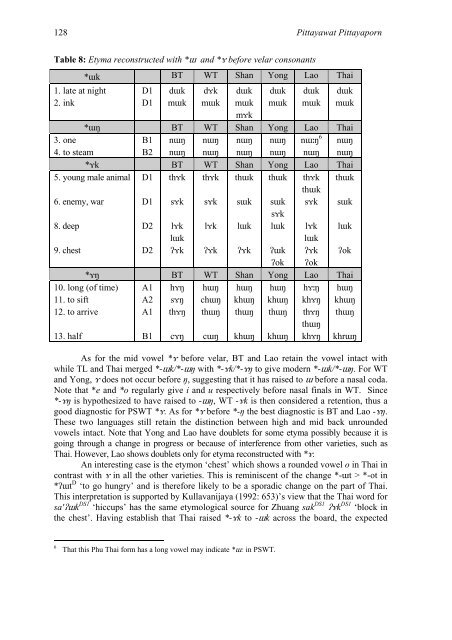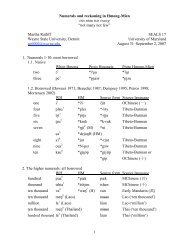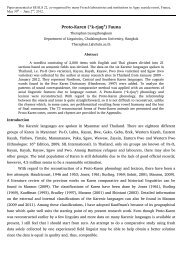proto-southwestern-tai revised: a new reconstruction - seals 22
proto-southwestern-tai revised: a new reconstruction - seals 22
proto-southwestern-tai revised: a new reconstruction - seals 22
You also want an ePaper? Increase the reach of your titles
YUMPU automatically turns print PDFs into web optimized ePapers that Google loves.
128 Pittayawat Pittayaporn<br />
Table 8: Etyma reconstructed with *ɯ and *ɤ before velar consonants<br />
1. late at night<br />
2. ink<br />
*ɯk BT WT Shan Yong Lao Thai<br />
D1<br />
D1<br />
dɯk<br />
mɯk<br />
dɤk<br />
mɯk<br />
dɯk<br />
mɯk<br />
mɤk<br />
dɯk<br />
mɯk<br />
sɯk<br />
sɤk<br />
lɯk<br />
dɯk<br />
mɯk<br />
dɯk<br />
mɯk<br />
*ɯŋ BT WT Shan Yong Lao Thai<br />
3. one<br />
B1 nɯŋ nɯŋ nɯŋ nɯŋ nɯːŋ<br />
4. to steam<br />
B2 nɯŋ nɯŋ nɯŋ nɯŋ<br />
6<br />
nɯŋ<br />
nɯŋ nɯŋ<br />
*ɤk BT WT Shan Yong Lao Thai<br />
5. young male animal D1 thɤk thɤk thɯk thɯk thɤk<br />
thɯk<br />
thɯk<br />
6. enemy, war D1 sɤk sɤk sɯk<br />
sɤk sɯk<br />
8. deep<br />
D2 lɤk lɤk lɯk<br />
lɤk lɯk<br />
lɯk<br />
lɯk<br />
9. chest<br />
D2 ʔɤk ʔɤk ʔɤk ʔɯk ʔɤk ʔok<br />
ʔok ʔok<br />
*ɤŋ BT WT Shan Yong Lao Thai<br />
10. long (of time) A1 hɤŋ hɯŋ hɯŋ hɯŋ hɤːŋ hɯŋ<br />
11. to sift<br />
A2 sɤŋ chɯŋ khɯŋ khɯŋ khɤŋ khɯŋ<br />
12. to arrive A1 thɤŋ thɯŋ thɯŋ thɯŋ thɤŋ<br />
thɯŋ<br />
thɯŋ<br />
13. half<br />
B1 cɤŋ cɯŋ khɯŋ khɯŋ khɤŋ khrɯŋ<br />
As for the mid vowel *ɤ before velar, BT and Lao re<strong>tai</strong>n the vowel intact with<br />
while TL and Thai merged *-ɯk/*-ɯŋ with *-ɤk/*-ɤŋ to give modern *-ɯk/*-ɯŋ. For WT<br />
and Yong, ɤ does not occur before ŋ, suggesting that it has raised to ɯ before a nasal coda.<br />
Note that *e and *o regularly give i and u respectively before nasal finals in WT. Since<br />
*-ɤŋ is hypothesized to have raised to -ɯŋ, WT -ɤk is then considered a retention, thus a<br />
good diagnostic for PSWT *ɤ. As for *ɤ before *-ŋ the best diagnostic is BT and Lao -ɤŋ.<br />
These two languages still re<strong>tai</strong>n the distinction between high and mid back unrounded<br />
vowels intact. Note that Yong and Lao have doublets for some etyma possibly because it is<br />
going through a change in progress or because of interference from other varieties, such as<br />
Thai. However, Lao shows doublets only for etyma reconstructed with *ɤ.<br />
An interesting case is the etymon ‘chest’ which shows a rounded vowel o in Thai in<br />
contrast with ɤ in all the other varieties. This is reminiscent of the change *-ɯt > *-ot in<br />
*ʔɯt D ‘to go hungry’ and is therefore likely to be a sporadic change on the part of Thai.<br />
This interpretation is supported by Kullavanijaya (1992: 653)’s view that the Thai word for<br />
sa'ʔɯk DS1 ‘hiccups’ has the same etymological source for Zhuang sak DS1 ʔɤk DS1 ‘block in<br />
the chest’. Having establish that Thai raised *-ɤk to -ɯk across the board, the expected<br />
6 That this Phu Thai form has a long vowel may indicate *ɯ: in PSWT.





